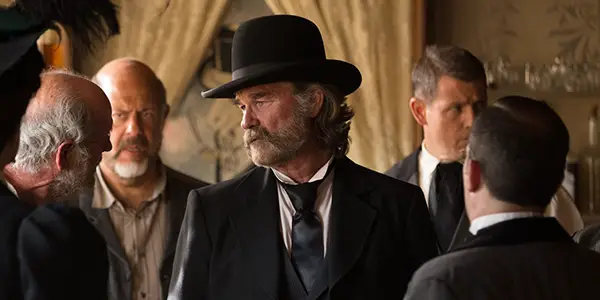Despite a reputation as an open minded viewer willing to watch cinema of all genres, I have a confession to make: I struggle with Westerns, with many widely acclaimed masterpieces leaving me cold for no easily discernible reason. As much as I love Sergio Leone and many recently made “revisionist Westerns”, how the cornerstones of the genre (the majority of which are directed by John Ford) earned their classic status is unfathomable to me.
I don’t want to feel ignorant of such a vital genre of 20th century cinema, but there is something outdated and mildly repugnant about films that romanticise a bygone era that is shrouded in darkness, seldom acknowledged by the masterpieces in question.
Bone Tomahawk will appeal to old-school fans and recent converts
Bone Tomahawk, the directorial debut of prolific genre author S. Craig Zahler, manages to bridge the gap between the tone of classic Westerns and the hyper-violent demands of revisionist entries to the genre. It is unlikely to win over any modern audiences unaccustomed to the slow pacing or cheerily banter-heavy dialogue that populated films like Howard Hawks’ Rio Bravo, of which this is frequently tonally reminiscent. However, the fact that Zahler manages to appease both old-school fans and recent converts to the genre (who have more blood-soaked demands from their Westerns of choice) in one fell swoop isn’t something to be sneered at.
In the quaint frontier town of Bright Hope at an undisclosed time period around the turn of the 20th century, forgetful sheriff’s deputy Chicory (Richard Jenkins) remarks to Sheriff Franklin Hunt (Kurt Russell) that he saw a drifter outside the town burying blood-stained clothes. When they go to the local bar to confront the drifter, minor bloodshed occurs, leading him to be impounded in the prison for the evening.
The same evening, a stablehand is violently murdered, with the only sign of a clear culprit being an arrow left at the site; the insignia of a nearby tribe. Knowing that going to confront them alone would be suicide, Hunt, Chicory, Brooder (Matthew Fox) and the injured Arthur O’Dwyer (Patrick Wilson) set off on a team mission to locate the perpetrators of the heinous crimes.

Preparing for his role in Quentin Tarantino’s high profile Western The Hateful Eight, Kurt Russell stars as Sheriff Franklin Hunt. It doesn’t feel like a strong comeback role so much as a warm-up for his next foray into the old West. This isn’t detrimental whatsoever to his performance here – in the strong central role he plays a much more brooding figure in comparison to the quirkier roles inhabited by his costars.
The mixture of graphic violence and oddball humour make it of a piece with another left-field directorial debut in the genre this year: John Maclean’s Slow West, which applied a Wes Anderson-themed style to a typical Western narrative, yet equally had a central figure less quirky than his co-stars, in this case the role played by Michael Fassbender.
The humour in Bone Tomahawk is considerably broader than that more indie-spirited 2015 effort; Richard Jenkins’ sidekick performance benefits strongly from his abilities as a recent convert to comic acting. Even though he is usually playing the “straight man” against more idiotic characters, here he takes the buffoonery associated with comic actors he has worked with and subtly tweaks it to give a broad comic performance, rare in how understated it is.
Less Western, more exploitation
As the film builds up to its later stages, it relishes a graphic violence seldom seen in cinema outside of torture porn. The film is billed as a “horror western”, but more accurately should be described as a “horrific western”- as disgusting as the torture sequences may be, they are filmed with an icy detachment, stopping the viewing of them to become anything other than voyeuristic. As a character study, the movie is emotionally involving. In its most violent scenes, it acts solely to make you squirm as opposed to caring about the natures of the grisly fates served.
The horrific elements in Bone Tomahawk act as a ghastly spin on the story of the most feted Western of them all – John Ford’s The Searchers, a classic narrative that has been riffed-on extensively in pop culture, most notably inspiring Finding Nemo. Here, it has been given a gruesome tweak to help fit the film alongside the best of recent exploitation efforts, as well as a successful attempt to revive the genre at its most uncool.
The “troglodyte” tribe that have kidnapped some of the locals have been clearly distinguished from the local Native American community due to rumours of their fondness for prolonged torture and cannibalism. It is as far removed from the long-outdated resolution of The Searchers, which takes a Stockholm Syndrome twist and applies it in an eerily racist manner. Here, the villains are monstrosities only cinema could invent, allowing for a refreshing contemporary take on a classic western, where Native Americans aren’t perceived as the villains.
Conclusion
Like many esteemed classics of the genre, Bone Tomahawk is an exploitation movie at heart, but has the courage of its convictions to treat its material as a gory grindhouse feature, albeit one made with love and effort. It may not convert new audiences to this most traditional of genres, but it is a rare recent revisionist take that will please more than just the most hardcore of fans.
What are the best revisionist Westerns?
Bone Tomahawk is out now in the US and on February 19 in the UK. All international release dates can be found here.
Does content like this matter to you?
Become a Member and support film journalism. Unlock access to all of Film Inquiry`s great articles. Join a community of like-minded readers who are passionate about cinema - get access to our private members Network, give back to independent filmmakers, and more.